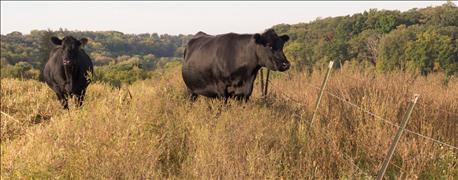November 7, 2016

Wisconsin’s 2016 growing season was good for grass, as abundant rainfall and optimal temperatures supported forage production. Certain internal parasites whose life cycles depend upon grass and grazing ruminants proliferated in response to all that grass.
Efficacy of the most commonly used dewormers today is 59%, and history shows effectiveness decreasing every year. Bottom line: 41% of your cattle’s worms may survive treatment if you routinely use a pour-on or injectable dewormer. Gone are the days of simply deworming cattle with a one-size-fits-all approach, while being blissfully ignorant of the complexity involved.
Deworming protocol

GET RID OF WORMS: Allow dewormed cattle to remain in the same area for at least a week after treatment.
Seek veterinary guidance to develop a deworming protocol tailored to your farm’s management. Base your protocols on proper worm diagnosis, which involves performing fecal egg counts (FEC). The Wisconsin Modified Sugar Flotation is a preferred FEC method. Test kits used for detecting internal parasites of small animals are not sensitive enough for use with ruminant herbivores.
Gastrointestinal worms (helminths or nematodes, like Ostertaia, Cooperia and Haemonchus) are found in various stages of life within cattle, in feces and on grass. The worms need all three environments in which to complete their life cycle; therefore, several opportunities exist for interrupting their growth. One such opportunity is afforded by Wisconsin’s winter.
Prepuberty and adult worm stages reside inside cattle, and may overwinter in cattle, serving as a source of eggs when defecated on pastures in the spring. Larval stages of worms survive frozen pasture conditions and also serve as a source of infestation as the grass begins to grow in the spring.
Deworming products are administered to cattle in an attempt to kill worm stages found inside cattle. Deworming late in the fall after several hard freezes will help reduce the number of internal worm stages carried over winter by cattle, and any treated survivors will be depositing their eggs into frozen conditions. Helminth eggs do not survive freezing.
Performing a laboratory fecal egg count reduction test (FECRT) along with species identification of the surviving worms will allow you to develop a treatment strategy for those internal, possibly dewormer-resistant survivors.
Deworming itself does not affect the worm stages out on grass at the time the cattle are treated; however, management of treated cattle does affect what type of worm eggs are deposited, and where. These resistant survivors probably originated from resistant pasture larvae that will overwinter outside. FECRT and species identification of the worms overwintering in cattle provide needed information for developing spring deworming plans for grazing cattle consuming these resistant larvae.
Allow dewormed cattle to remain in the same area for at least a week after treatment. Once moved onto another paddock, larvae that survived treatment are spreading resistant eggs to this new area. When stockpiled forages or bedding packs are used, resistant eggs may find themselves in microenvironments conducive to their hatching into resistant larvae.
Next spring, allow your oldest stock to graze areas where you suspect resistant larvae may reside first. Older animals are more tolerant of worms, and with FECs and species identification 30 days after turnout, you will have an indication of the pasture’s larvae infestation. Perform a 14-day post-treatment FECRT to know the efficacy of your dewormer investment. To be considered efficacious, the FECRT should be 95% or better.
Stuttgen is a veterinarian and is the Taylor County Extension agriculture educator.
You May Also Like




